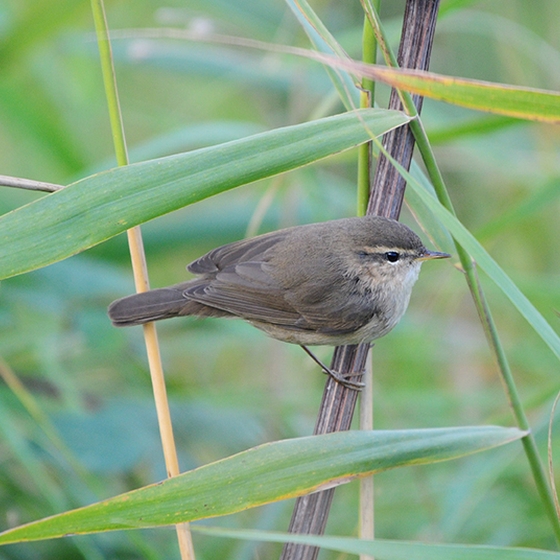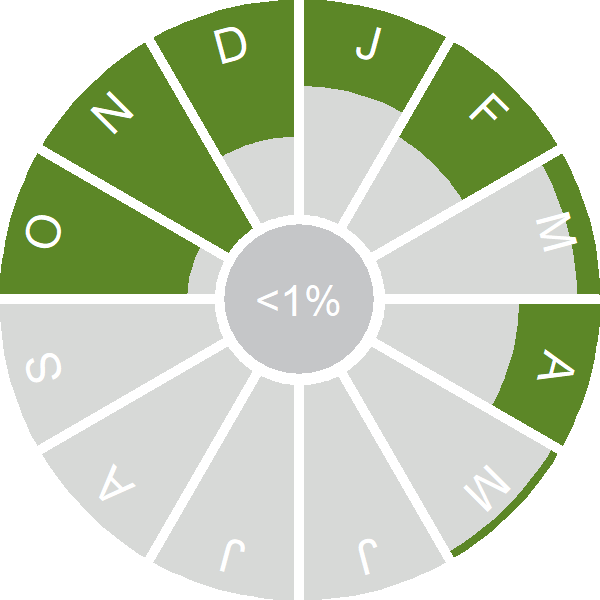Dusky Warbler

Introduction
Somewhat similar to a Chiffchaff, Dusky Warbler is a regular but scarce visitor from north-eastern Asia. Most records come late in the autumn and a few individuals have overwintered.

Key Stats
Identification
Songs and Calls
Call:
Status and Trends
Conservation Status
Population Size
Population Change
Dusky Warbler is a scarce migrant in the UK. The number of recorded sightings and the number of individuals attempting to overwinter here have both increased in recent years, leading to the first singing males being observed in 2022 [White & Kehoe 2024; Eaton & the Rare Breeding Birds Panel 2024]. Little is known about the population status of Dusky Warblers but the population is considered to be stable as there is no evidence of a decline [BirdLife International 2016].
Distribution
This species is a rare vagrant and was recorded during Bird Atlas 2007–11 as shown on the map.
Occupied 10-km squares in UK
2007/08–10/11
or view it on Bird Atlas Mapstore.
2008–11
or view it on Bird Atlas Mapstore.
Distribution Change
This vagrant is too rarely reported to map distribution change.
Change in occupied 10-km squares in the UK
Seasonality
Dusky Warbler is a rare autumn vagrant, usually encountered in October and November, some birds have wintered.
Weekly pattern of occurrence
The graph shows when the species is present in the UK, with taller bars indicating a higher likelihood of encountering the species in appropriate regions and habitats.

Movement
Britain & Ireland movement
Foreign locations of birds ringed or recovered in Britain & Ireland
Dots show the foreign destinations of birds ringed in Britain & Ireland, and the origins of birds ringed overseas that were subsequently recaptured, resighted or found dead in Britain & Ireland. Dot colours indicate the time of year that the species was present at the location.
- Winter (Nov-Feb)
- Spring (Mar-Apr)
- Summer (May-Jul)
- Autumn (Aug-Oct)

Biology
Survival and Longevity
Survival is shown as the proportion of birds surviving from one year to the next and is derived from bird ringing data. It can also be used to estimate how long birds typically live.
View number ringed each year in the Online Ringing Report.
Classification, names and codes
Classification and Codes
- Order: Passeriformes
- Family: Phylloscopidae
- Scientific name: Phylloscopus fuscatus
- Authority: Blyth, 1842
- BTO 2-letter code: UY
- BTO 5-letter code: DUSWA
- Euring code number: 13030
Alternate species names
- Catalan: mosquiter fosc
- Czech: budnícek temný
- Danish: Brun Løvsanger
- Dutch: Bruine Boszanger
- Estonian: tõmmu-lehelind
- Finnish: ruskouunilintu
- French: Pouillot brun
- German: Dunkellaubsänger
- Hungarian: barna füzike
- Icelandic: Skúmsöngvari
- Irish: Ceolaire Breacdhorcha
- Italian: Luì scuro
- Latvian: tumšais kaukitis
- Lithuanian: tamsioji pecialinda
- Norwegian: Brunsanger
- Polish: swistunka brunatna
- Portuguese: felosa-sombria
- Slovak: kolibiarik hnedý
- Slovenian: rjava listnica
- Spanish: Mosquitero sombrío
- Swedish: brunsångare
- Welsh: Telor Tywyll
More Evidence
More evidence from Conservation Evidence.com
Partners
Citing BirdFacts
If you wish to cite particular content in this page (e.g. a specific value) it is best to use the original sources as linked in the page. For a more general citation of the whole page please use: BTO (20XX) BirdFacts Species: profiles of birds occurring in the United Kingdom. BTO, Thetford (www.bto.org/birdfacts, accessed on xx/xx/xxxx).

